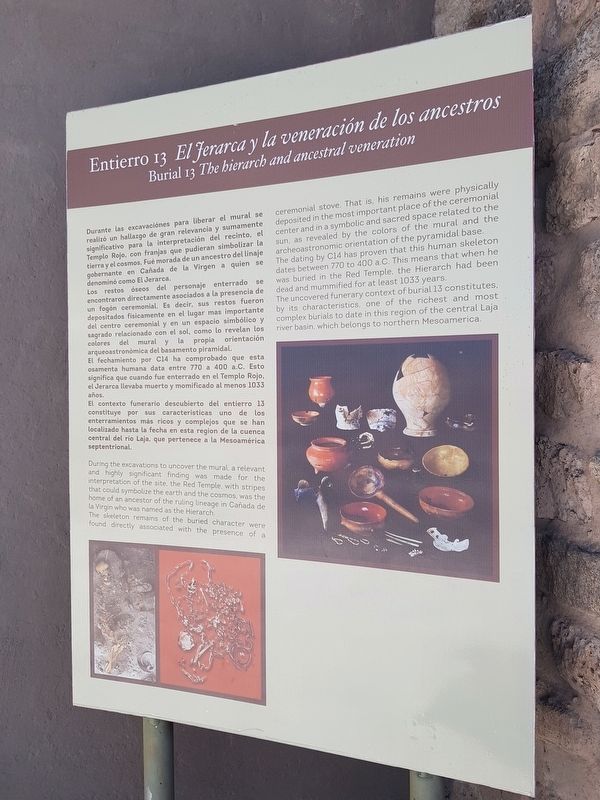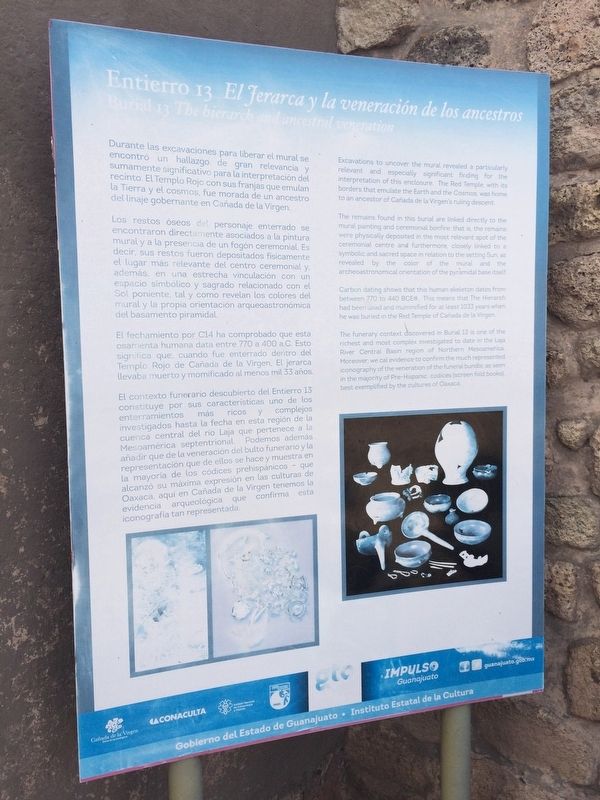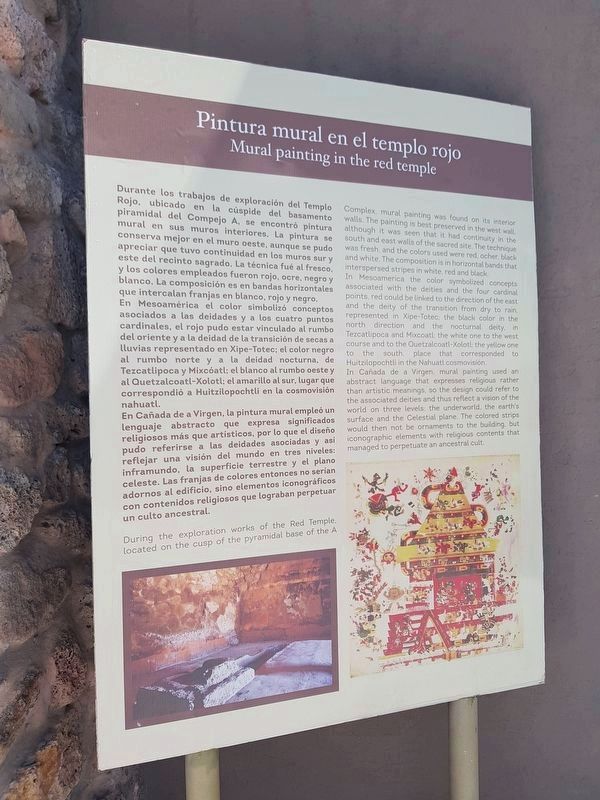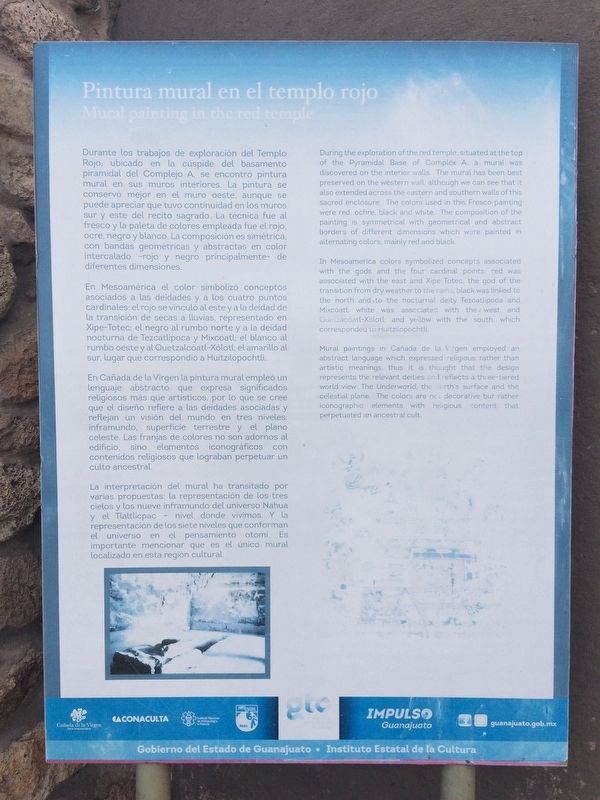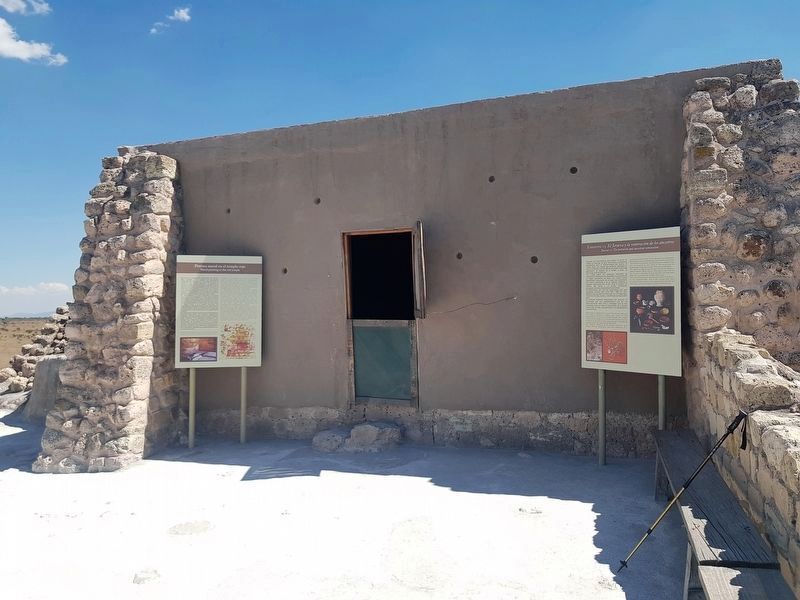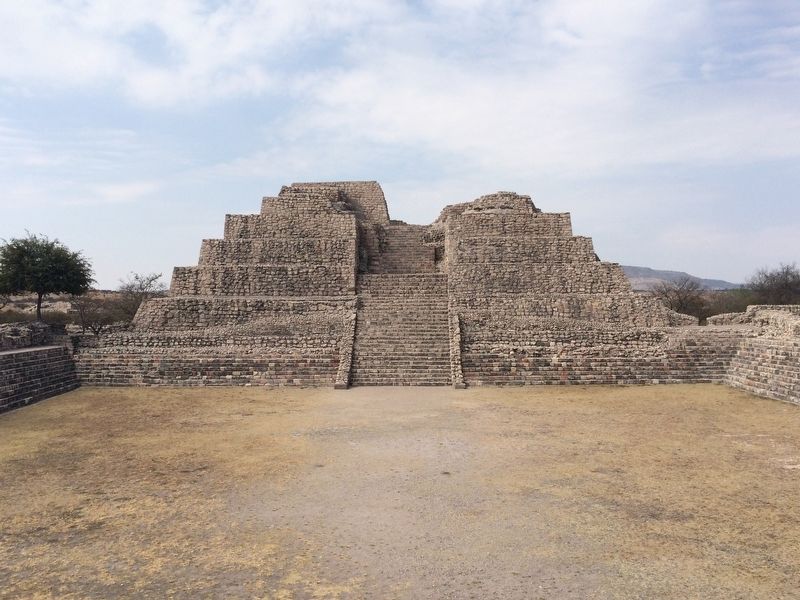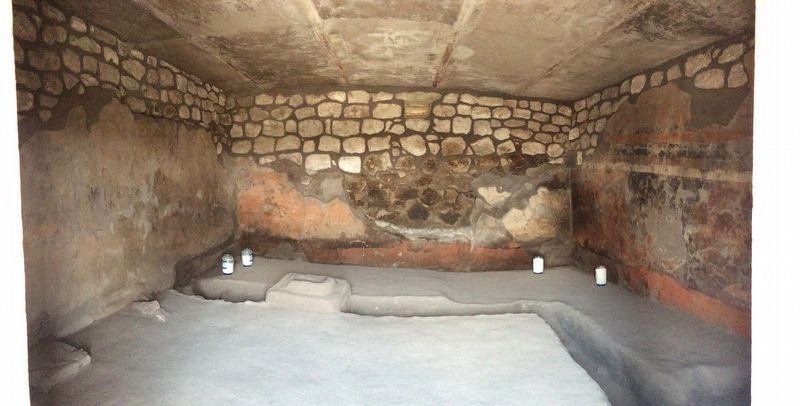San Miguel de Allende, Guanajuato, Mexico — The Central Highlands (North America)
Burial 13 The hierarch and ancestral veneration
Inscription.
Durante las excavaciones para liberar el mural se realizó un hallazgo de gran relevancia y sumamente significativo para la interpretación del recinto, el Templo Rojo, con franjas que pudieran simbolizar la tierra y el cosmos. Fué morada de un ancestro del linaje gobernante en Cañada de la Virgen a quien se denominó como El Jerarca.
Los restos óseos del personaje enterrado se encontraron directamente asociados a la presencia de un fogón ceremonial. Es decir, sus restos fueron depositados fisicamente en el lugar mas importante del centro ceremonial y en un espacio simbólico y sagrado relacionado con el sol, como lo revelan los colores del mural y la propia orientación arqueoastronómica del basamento piramidal.
El fechamiento por C14 ha comprobado que esta osamenta humana data entre 770 a 400 a.C. Esto significa que cuando fue enterrado en el Templo Rojo, el Jerarca llevaba muerto y momificado al menos 1033 años.
El contexto funerario descubierto del entierro 13 constituye por sus caracteristicas uno de los enterramientos más ricos y complejos que se han localizado hasta la fecha en esta region de la cuenca central del rio Laja, que pertenece a la Mesoamérica septentrional.
Burial 13 The hierarch and ancestral veneration
During the excavations to uncover the mural, a relevant and highly significant finding was made for the interpretation of the site, the Red Temple, with stripes that could symbolize the earth and the cosmos, was the home of an ancestor of the ruling lineage in Cañada de la Virgin who was named as the Hierarch.
The skeleton remains of the buried character were found directly associated with the presence of a ceremonial stove. That is, his remains were physically deposited in the most important place of the ceremonial center and in a symbolic and sacred space related to the sun, as revealed by the colors of the mural and the archeoastronomic orientation of the pyramidal base.
The dating by C14 has proven that this human skeleton dates between 770 to 400 a. C. This means that when he was buried in the Red Temple, the Hierarch had been dead and mummified for at least 1033 years. The uncovered funerary context of burial 13 constitutes, by its characteristics, one of the richest and most complex burials to date in this region of the central Laja river basin, which belongs to northern Mesoamerica.
Erected by
Consejo Nacional para la Cultura y las Artes de México (CONACULTA) and INAH.
Topics. This historical marker is listed in these topic lists: Anthropology & Archaeology • Native Americans.
Location. 20° 51.495′ N, 100° 55.718′ W. Marker is in San Miguel de Allende, Guanajuato. Marker can be reached from Route 67. The marker is at the top of the main pyramid at the archaeological site of Cañada de la Virgen. The site is to the left when traveling north on State Road 67, some 30 km west of San Miguel de Allende. Touch for map. Marker is in this post office area: San Miguel de Allende GTO 37701, Mexico. Touch for directions.
Other nearby markers. At least 8 other markers are within walking distance of this marker. Complex B: The House of the Longest Night (within shouting distance of this marker); Observing the Stars (within shouting distance of this marker); Layout and Architecture (within shouting distance of this marker); Burial 18 The Decapitated Man (within shouting distance of this marker); Complex A The House of the Thirteen Heavens (within shouting distance of this marker); Complex D. The wind house. (The house of the wind) (about 90 meters away, measured in a direct line); Cañada de la Virgen: A Ceremonial Civic Center in the Laja River Basin Marker (about 150 meters away); Ceremonial Road (about 180 meters away). Touch for a list and map of all markers in San Miguel de Allende.
Additional commentary.
1. Text of additional marker, "Mural Painting in the Red Temple"
Pintura mural en el templo rojo
Durante los trabajos de exploración del Templo Rojo, ubicado en la cúspide del basamento piramidal del Complejo A, se encontró pintura mural en sus muros interiores. La pintura se conservó mejor en el muro oeste, aunque se puede apreciar que tuvo continuidad en los muros sur y este del recito sagrado. La técnica fue al fresco y la paleta de colores empleada fue el rojo, ocre, negro y blanco. La composición es simétrica, con bandas geométricas y abstractas en color intercalado - rojo y negro principalmente – de diferentes dimensiones.
En Mesoamérica el color simbolizó conceptos asociados a las deidades y a los cuatro puntos cardinales: el rojo se vinculó al este y a la deidad de la transición de secas a lluvias, representado en Xipe Totec; el negro al rumbo norte y a la deidad nocturna de Tezcatlipoca y Mixcoatl; el blanco al rumbo oeste y al Quetzalcóatl-Xólotl; elamarillo al sur, lugar que correspondió a Huitzilopochtli.
En Cañada de la Virgen la pintura mural empleó un lenguaje abstracto que expresa significados religiosos más que artísticos, por lo que se cree que el diseño refiere a las deidades asociadas y reflejan un visión del mundo en tres niveles: inframundo, superficie terrestre y el plano celeste. Las franjas
de colores no son adornos al edificio, sino elementos iconográficos con contenidos religiosos que lograban perpetuar un culto ancestral.
La interpretación del mural ha transitado por varias propuestas: la representación de los tres cielos y los nueve inframundo del universo Nahua y el Tlaltlicpac - nivel donde vivimos. Y la representación de los siete niveles que conforman el universo en el pensamiento otomí. Es importante mencionar que es el único mural localizado en esta región cultural.
English:
Mural painting in the red temple
During the exploration of the red temple, situated at the top of the Pyramidal Base of Complex A, a mural was discovered on the interior walls. The mural has been best preserved on the western wall, although we can see that it also extended across the eastern and southern walls of this sacred enclosure. The colors used in this Fresco painting were red, ochre, black and white. The composition of the painting is symmetrical with geometrical and abstract borders of different dimensions which were painted in alternating colors, mainly red and black.
In Mesoamerica colors symbolized concepts associated with the gods and the four cardinal points: red was associated with the east and Xipe Totec, the god of the transition from dry weather to the rains; black was linked to the north and to the nocturnal deity Tezcatlipoca
and Mixcoatl; white was associated with the west and Quetzacóatl-Xólotl; and yellow with the south which corresponded to Huitzilopochtli.
Mural paintings in Cañada de la Virgen employed an abstract language which expressed religious rather than artistic meanings, thus it is thought that the design represents the relevant deities and reflects a three-tiered world view: The Underworld, the earth's surface and the celestial plane. The colors are not decorative but rather iconographic elements with religious content that perpetuated an ancestral cult.
English translation of marker’s last paragraph:
There have been many interpretations of the mural’s meaning. One interpretation is that it represents the ‘three skies’ of the celestial plane, the nine levels of the underworld and the ‘Tlaltlicpac’ – the level where we live, all in in the Nahua universe. Another interpretation is that it represents the seven levels of the universe in the Otomi culture. It is important to note that this is the only mural located in this cultural region.
— Submitted June 7, 2017, by J. Makali Bruton of Accra, Ghana.
Additional keywords. Burial 13 The hierarch and ancestral veneration
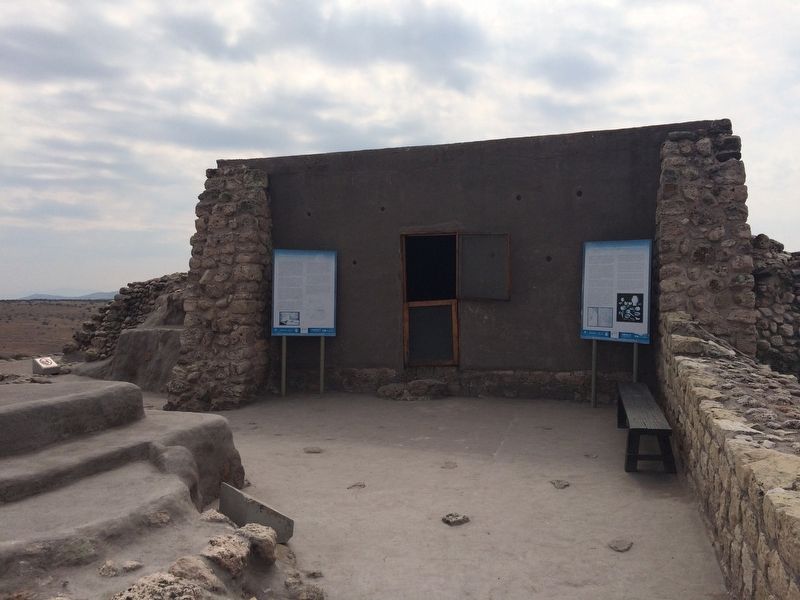
Photographed By J. Makali Bruton, February 5, 2017
6. The previous Burial 13 The hierarch and ancestral veneration Marker
The previous version of the marker is to the right of the entrance to the mural remains. To the left is the previous version of the "Mural Painting in the Red Temple" additional marker.
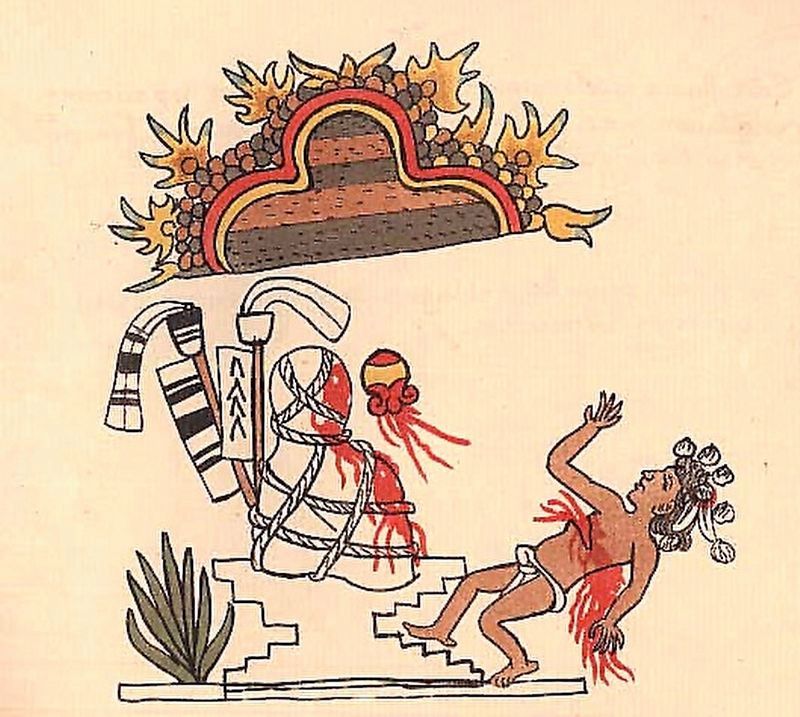
7. Prehispanic mesoamerican burial
This image from the 16th century Magliabecchiano Codex shows an image of a 'sacred bundle' type of burial that could have been similar to that of the "Hierarch" at Cañada de la Virgen. This image is from the Aztec culture and it is not clear which culture lived at Cañada de la Virgen. This image is in the public domain.
Credits. This page was last revised on September 1, 2020. It was originally submitted on June 6, 2017, by J. Makali Bruton of Accra, Ghana. This page has been viewed 171 times since then and 9 times this year. Photos: 1. submitted on March 7, 2020, by J. Makali Bruton of Accra, Ghana. 2. submitted on June 6, 2017, by J. Makali Bruton of Accra, Ghana. 3. submitted on March 7, 2020, by J. Makali Bruton of Accra, Ghana. 4. submitted on June 7, 2017, by J. Makali Bruton of Accra, Ghana. 5. submitted on March 7, 2020, by J. Makali Bruton of Accra, Ghana. 6. submitted on June 6, 2017, by J. Makali Bruton of Accra, Ghana. 7. submitted on June 7, 2017, by J. Makali Bruton of Accra, Ghana. 8, 9. submitted on June 6, 2017, by J. Makali Bruton of Accra, Ghana.
